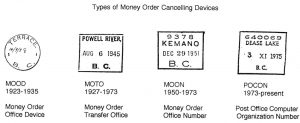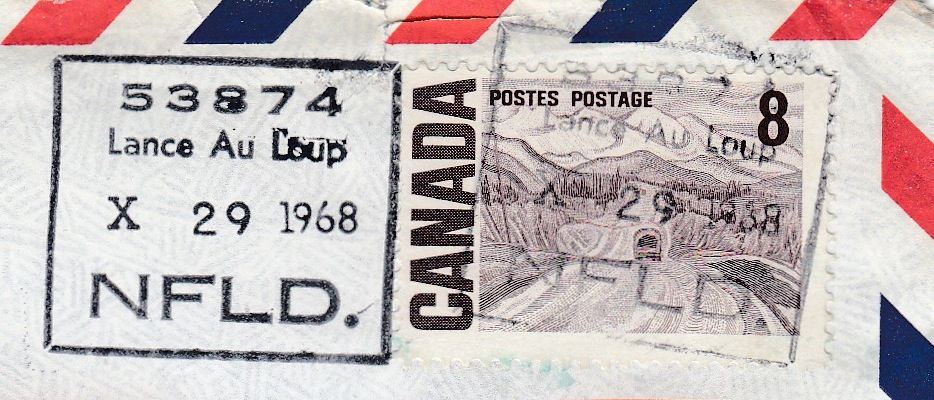A member of the BNAPS (British North America Philatelic Society) is seeking scans and photocopies of Money Order Office Number (MOON) cancels for a new handbook.
Michael Sagar, of Richmond, B.C., has been chronicling the MOON cancels of Canada for more than two decades, during which time he produced six handbooks on the specialized area of collecting.
The MOON system was introduced in 1923, said Sagar, who’s also secretary and treasurer of BNAPS Postal Stationery Study Group.
“A four-digit number was assigned to each post office, presumably to ease with accounting,” he said. “Rather than Vancouver Sub Post Office Number 2, the entry would be ‘9812.’”
The numbers first appeared on pre-cancelled stamps and post office forms after replacing the Money Order Transfer Office (MOTO) system.
According to Sagar, integrating a post office’s MOON into a rubber cancel “started in earnest” in 1950 and continued until the MOON system became obsolete in the spring of 1973, when cancels with the six-digit Post Office Computer Organization Number (POCON) were introduced.
Sagar said MOON cancels were the third of four families of cancels issued by the Post Office Department. They were generally rectangular and included the date; town name; and post office number. Numbers were assigned by province and then alphabetically within each province.
“Within MOON cancels themselves, a number of distinct styles appeared over their 23 years of existence. I have classified them into 16 major groups.”
HOW DID THE MOON SYSTEM WORK?

Sagar said integration of a post office’s MOON into a rubber cancel (third from left) began in 1950. (Photo by Sagar)
Sagar said each province was assigned a series of numbers for their post offices (Quebec was assigned 0001-1999, Ontario was assigned 2000-4999, and so on).
“Holes were left in the assignments to accommodate potential name changes or expansions in urban areas,” he said. “Initially only ‘Accounting’ post offices – larger post offices with a full range of services – were assigned a MOON. In 1935, ‘non-accounting’ post offices – typically smaller, sometimes seasonal, with a narrower range of services including offering Money Orders in small amounts unto $15.99 – were assigned five-digit MOONs.”
Sagar said paperwork such as money order forms, internal post office forms and receipts were printed with the post office’s MOON; however, the system eventually spread into postal markings and numbered precancels.
“One of the initial problems with the MOON system was that Canada really needed 11,000 numbers, not 10,000 that a four-digit system would allow,” said Sagar. “The three Maritime provinces were assigned four-digit MOONs where the first character was an ‘X.’ When Newfoundland joined Confederation in 1949, their post offices were assigned a four-digit MOON starting with a ‘Y.’”
Further expansion and computerization of the postal system required a new way of tracking post office finances, and by April 1973, Canada moved all post offices to the six-digit POCON system.
FASCINATING & INEXPENSIVE
Sagar said his interest was piqued by MOON cancels while studying the postmarks of British Columbia.
“I found them fascinating, cheap – at the time – and had little competition. When acquiring new B.C. MOON cancels became more difficult, I expanded into all the other provinces,” he said, adding he’s also a collector of the postal stationery of Canada and Newfoundland.
NEW HANDBOOK
Sagar is planning to release his new handbook – this on the MOON cancels of Newfoundland; the military; the Northwest Territory and Yukon Territory; transportation; and events – in May.
“I have about 900 MOON cancels of Newfoundland listed (1950-1973), but would appreciate hearing from BNAPS members interested in contributing to my project or who may have items that can aid my research,” he said.
“I am interested in different hammers, early and late dates, and even ink colour. Cancels can be on cover, card, stamp, or post office paperwork like receipts. Philatelic or commercial usage – I don’t care.”
Sagar is asking collectors to send their scans by email or photocopies by mail, preferably by March 31. All contributors will be acknowledged in the introduction of the handbook.
Scans can be sent to gailandmike@shaw.ca, and physical submissions can be sent to 3920 Royalmore Ave., Richmond, B.C., V7C 1P6.

